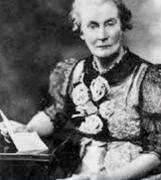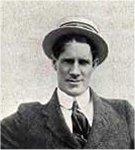|
|
||||||||||||||||||||||||
 |
Featured person
Recently added |
Agnes Nesta Shakespeare Higginson Skrine (1864 - 1955): |
||||||||||||||||||||||

|
| Moira O'Neill |
Agnes, or Nesta as she was known, was born into a family from Cushendun, north County Antrim, and though her actual place of birth on July 13th 1864 was Mauritius, she grew up in the Glens area of County Antrim and considered herself very much a Glenswoman. Her parents were cousins: her father Charles Higginson was a colonial administrator based for a time in Mauritius; her mother was Mary Higginson, daughter of Sir James MacAuley Higginson KCB, Governor of Mauritius. She had four brothers, who all entered the military, and two sisters. Sometime around 1874 the family moved to Rockport, Cushendun. She began publishing her work in 1892, with several poems in Blackwood’s Magazine, one of the leading British review publications of its day. In 1893 came a book for children, “The Elf-Errant”, illustrated by the then-prominent WEF Britten. and 1894 saw a short novel, “An Easter Vacation”. Poet Laureate John Masefield would describe it as “a happy and witty book, containing one of the best studies known to me of a high spirited, finely natured boy".
On 5 June 1895 Agnes married, at Cushendun, Walter Clarmont Skrine, of Warleigh, Somerset, who had considerable land holdings in Alberta. The couple moved there and settled on the Bar S Ranch, 24 miles southwest of High River. Walter had nearly 17,000 acres under lease and built a new, two-storey home for his bride, the lumber freighted from Calgary by teams of horses. The Skrines lived there for six years, before returning to Ireland in 1902
Agnes of course took her married name, but nevertheless continued to write under the same nom de plume, mostly, but not exclusively, poetry highly evocative of Cushendun and its environs; some of this output was published in Blackwood’s, and in 1901 there appeared a substantial separate anthology, Songs of the Glens of Antrim. But she also wrote about the Alberta she knew: “I like the endless riding over the endless prairie, the winds sweeping the grass, the great silent sunshine, the vast skies and the splendid line of the Rockies, guarding the west.” Masefield’s commentary on the Songs spoke of “poignant poems about her homeland, a few miles of the Irish coast, glen, moorland, mountain, and the sea, long-loved and made more intensely precious by exile.” By this time the expanding family had returned from Canada, settling initially at Ballymore Eustace, County Kildare, latterly at Ferns, County Wexford. The Songs were becoming more and more popular, and apart from selling well they attracted the attention of some very prominent musicians looking for texts to set and impressed by these. One of these was the Irish composer Sir Charles Villiers Stanford; another, Ulsterman Sir Hamilton Harty, the celebrated conductor and composer; both of these set several of the Songs. In Harty’s case Agnes was one of his more favourite sources: Boosey, the leading London music publisher, produced “The Song of Glendun” as early as 1902, “The Sailor Man" and "Denny’s Daughter" as late as 1938. Recordings of musical settings were committed to disc by amongst others, Harry Plunkett Greene, one of the leading baritones of the earlier twentieth century; and Kathleen Ferrier, the internationally acclaimed alto who later attained almost legendary status.
In 1921 there were two notable events in the Skrine family: first, their house at Ferns fell victim to the then Troubles, being burned badly, forcing the family to decamp Northwards; however, secondly, there appeared a further collection, More Songs of the Glens of Antrim. Further, the house was restored and the family was able to move back. In 1933 her Collected Poems was published. Agnes contributed a Preface in which she stated: “These songs of the Glens of Antrim were written by a Glenswoman in the dialect of the Glens and chiefly for the pleasure of other Glens-people.” This may be riposte to a critique of her work not seldom encountered, that she employed an inauthentic dialect of Irish-English, though this was a critique not of her work alone; Nevertheless the reference to her in the authoritative Grove in relation to those of her texts set by Stanford, states baldly: “The appeal of these settings, which often use a rather mannered colloquial, now dated, native speech, is limited.”
The Skrines had five children, one daughter of whom, Mary Nesta Skrine, became the writer Molly Keane.
| Born: | 13 July 1864 |
| Died: | 22 January 1955 |
| Richard Froggatt |
| Acknowledgements: Deirdre McMahon, University of Limerick; Maud Hamill, Chris Spurr, Ulster History Circle |
| Bibliography: Skrine, Agnes ."Women in World History: A Biographical Encyclopedia”. Encyclopedia.com;oxfordmusiconline.com; abheritage.ca/pasttopresent/settlement/aa_Agnes_Skrine; Ian d’Alton: “Molly Keane”, Dictionary of Irish Biography, (Royal Irish Academy, 2009); Linde Lunney & Bridget Hourican: “Agnes Skrine”, Dictionary of Irish Biography, Royal Irish Academy, 2009; Hogan, Robert. Dictionary of Irish Literature. Vol. 2. Westport, CT: Greenwood Press, 1996;Quinn, John, (ed). "Molly Keane," in A Portrait of the Artist as a Young Girl. London: Methuen. 1986.The Times (London). January 25, 29, 1955; February 3, 7, 10, 1955 |


Home | Our Policies | Plaques | Browse | Search | Sponsors | Links | Help | Contact
Privacy & Disclaimer | Cookie Policy | Site Map | Website Design By K-Point
© 2024 Ulster History Circle









